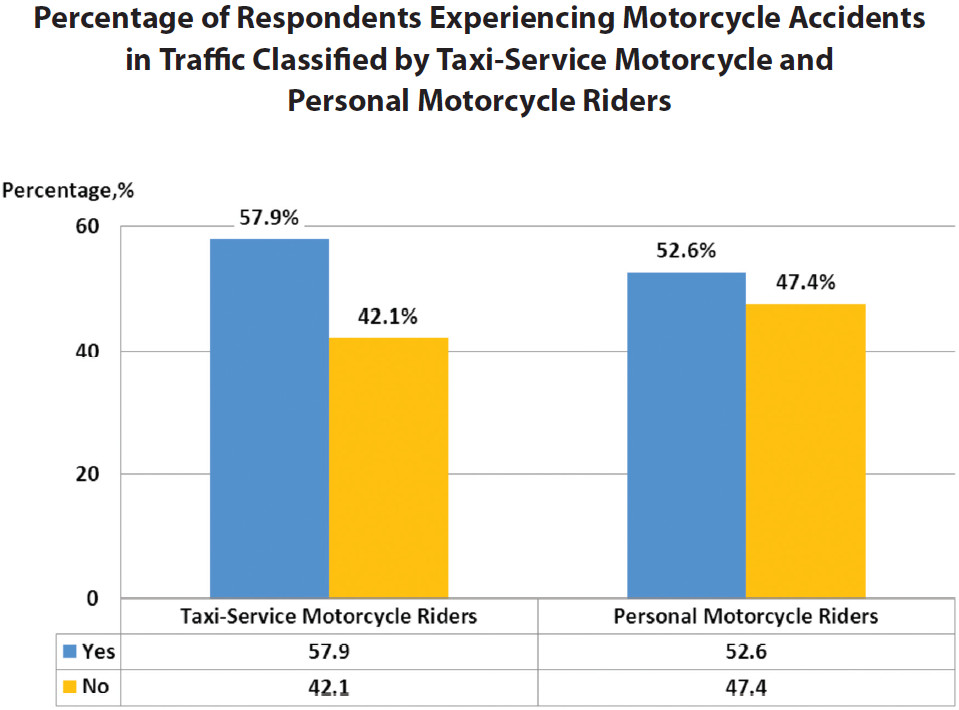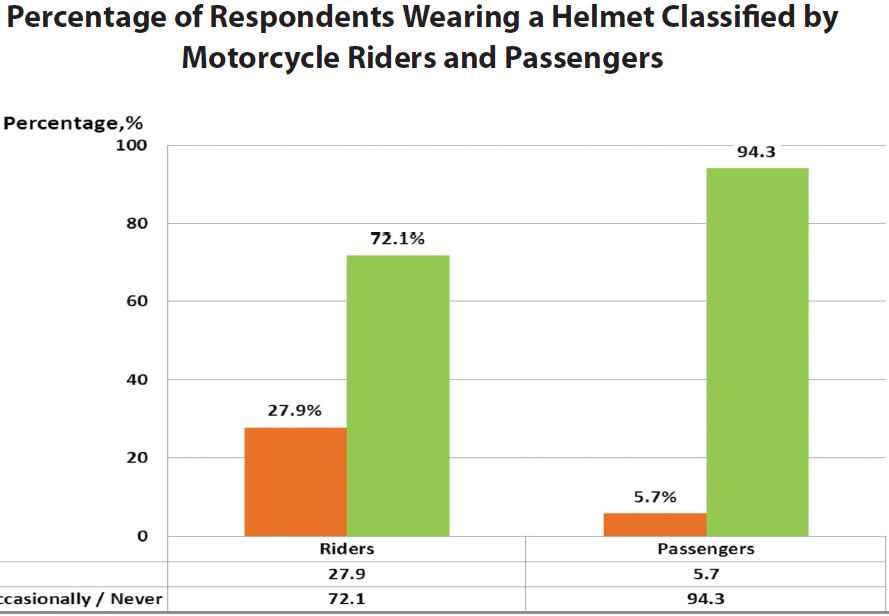It is well documented that wearing a helmet can reduce motorcycle crash fatalities. In 20071 it was reported that there were 37% fewer fatalities for riders wearing a helmet and 41% fewer motorcycle passenger fatalities.2 Furthermore, motorcyclists not wearing helmets were three times more likely to suffer brain injury.3 In Thailand, there are no statistics available on motorcycle accidents and the use of helmets.
This report is a collaboration between the ABAC Poll Research Center and the Bangkok Health Research Center (BHR center) to survey and ask respondents about wearing a helmet (both the rider and passenger) on both personal and taxi service motorcycles.
The survey aimed to determine current level of risk of suffering head injuries from motorcycle accidents when helmets were not worn. The poll was conducted from December 12-20, 2012 and 836 motorcycle passengers in Bangkok were interviewed, aged 15 years and above. The majority of taxi-service motorcycles (57.9%) and more than half of all personal motorcycle riders (52.6%) had been in an accident before.
The most concerning issue is that, when asking the respondents about the helmet wearing habits of both riders and passengers, it was found that 72.1% of riders and 94.3% of passengers did not wear helmets or wore them only occasionally. Only 27.9% of riders and 5.7% of passengers always used helmets when travelling by motorcycle.
When respondents were asked about their experience of witnessing motorcycle riders and passengers being arrested for not wearing a helmet (in the past 3 months), the majority of motorcycle passengers (62.8%) and over half of the taxi-service motorcycle passengers (51.7%) had never seen an arrest take place. Likewise, the riders of both personal motorcycles (45.6%) and taxi-service motorcycles had never seen the police arrest someone because they were not wearing a helmet.
The majority of riders and passengers on personal motorcycles, (54.1% and 74.4%, respectively), had never been arrested by the police when they were not wearing a helmet. Similarly 43.0% of taxi-service motorcycle riders and 76.4% of motorcycle taxi passengers had not been arrested either.
The study discovered that 64.8% of passengers who travel by taxi-service motorcycles and 49.9% of personal motorcycles had children travelling with them. These two groups of motorcycle passengers, taxi-service motorcycle riders and personal motorcycle passengers, never put helmets on children riders or only occasionally put helmets on children riders about 83.5% and 93.3% of the time, respectively.

Figure 1: Shows the percentage of respondents who have been in a motorcycle traffi c accident classifi ed by taxi-service motorcycle and personal motorcycle riders.

Figure 2: Shows the percentage of respondents wearing a helmet classifi ed by motorcycle riders and passengers.
The reasons for not wearing or using a helmet were because:
− People were travelling a short distance and thought it would not be harmful (69.3%).
− There were no police on the particular street or road (39.3%).
− They were in a hurry or there was no time to put on a helmet (25.7%).
− Putting on a helmet is uncomfortable when riding and impairs their vision (21.8%).
Other reasons given by respondents include: helmets have a bad smell and are dirty; helmets mess up your hair; helmets might be stolen when hung up on the motorcycle; no storage room; the respondent does not have a helmet; and the police do not enforce the law.
The majority of passengers of both taxi-service and personal motorcycles who did not buckle the chin strap (or only buckled it occasionally) accounted for 70.9% and 54.5% of passengers, respectively. Likewise, a great number of riders of taxi-service and personal motorcycles did not buckle their chin strap (or only put it on occasionally) which accounted for 40.1% and 40.8% of riders, accordingly.
The findings about the relative risk statistical analysis by using Odds Ratio for the risk of head injuries from motorcycle accidents, found that the group of riders or passengers who did not buckle their chin strap were six times greater at risk of head injuries than the group that used their chin strap.
To reduce the number of motorcycle rider and passenger accidents, we recommend the following measures:
First, the police should strictly and constantly warn or impose a fine to motorcycle riders and passengers who do not wear a helmet.
Second, the government should formulate a policy to promote the use of helmets, “The Public Supports Helmets” (Muak Kan Nog Eur Arthorn). It could provide a piece of head covering cloth for one time use only or a cloth that is reusable after washing. This would encourage the habit of wearing a helmet and encourage low-income people to use a helmet when travelling by motorcycle.
Third, the government should consider a policy to make personal cars more affordable because the decrease in the use of motorcycles would reduce the risk of being injured in a motorcycle accident.
Fourth, the helmet manufacturing sector should be supported by the government to produce more helmets for children. Adults must pay more attention to children in terms of safety.
Fifth, personal cars and motorcycle riders and passengers should not assume that others will see their vehicles while riding or driving on the road. Drivers and riders should always turn on their headlights when they use their car or motorcycle in order to reduce accidents that may occur to themselves and others.
Sixth, both motorcycle and car passengers should be more conscious of observing the rule of the road and should respect other road users and pedestrians while riding or driving.
Lastly, drivers and riders must never consume any kind of alcohol while on the road because drink-driving can be a contributory cause of accidents that result in injury and death.
Of the respondents of this study, 68.3% were male and 31.7% were female. When classifying the sample by age, 32.9% were 20-29 years old, 29.9% were 30-39 years old, 22.9% were 40-49 years old, 8.7% were 50-59 years old,4.4% were 15-19 years old, and 1.2% were 60 years old or above. Regarding personal monthly income, 48.9% earned 5,001-10,000 Baht,31.1% earned10,001-15,000 Baht, 9.5% earned 15,001-20,000 Baht, 5.9% earned not more than 5,000 Baht, 3.8% earned 25,001 Baht or above and only 0.8% earned 20,001-25,000 Baht. When classified by education completed, 33.2% graduated high school, 31.7% graduated middle secondary school or lower, and 15.8% graduated with a bachelor’s degree. When classifying the sample by their current occupation, 40.2% were taxi-service motorcycle riders, 16.3% were employees of a private company, 11.8% were students/university students, 10.3% work for wages, and 9.7% were retailers/peddlers.
This research illustrates that motorcycle passengers who wear helmets correctly could reduce the risk of head injuries. It is frightening to discover that people are not aware of this issue because they think that accidents could never happen to them. Moreover, respondents believed that travelling or riding on a motorcycle for a short distance is not dangerous or would not be harmful. In fact, accidents can happen at any moment. Children are a high-risk group and are of the greatest concern when it comes to motorcycle accidents. Many children never wear a helmet because they are not provided with a helmet of an appropriate size. Furthermore, children are likely to sustain more severe and serious injuries, when compared to adults. For this reason, it is necessary that our hospitals should have a team of specialized doctors for such accidents. The findings supported that people are still not aware of the dangers of head injuries. Riding a motorcycle without wearing a helmet on a daily basis is high risk be- havior, yet respondents were not aware of this.
The risk of sustaining a head injury if involved in a motorcycle traffic accident while not wearing a helmet is statistically high. Wearing a helmet can save lives.
A public awareness campaign is needed in Thailand to protect children, who are at greater risk than adults of sustaining life-threatening head injuries. Children have the right to wear properly fitted helmets, yet these are too seldom provided. The traffic police have a duty to enforce the law of the road and to take appropriate measures when they intercept riders and passengers who are not wearing a helmet.